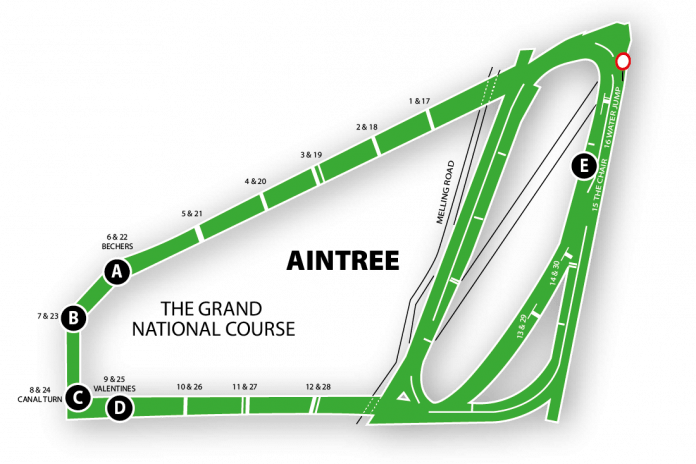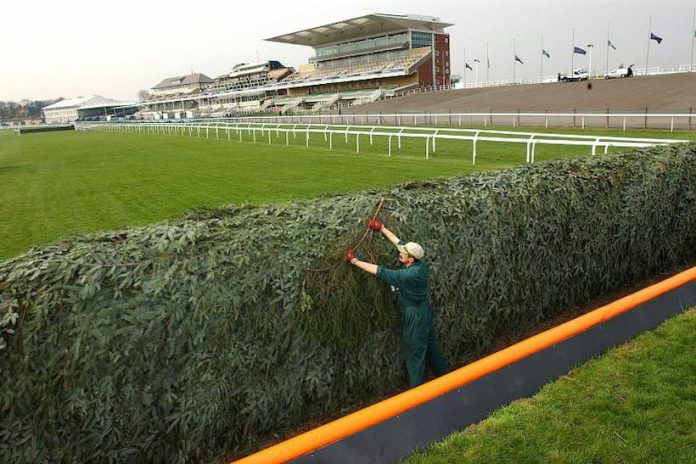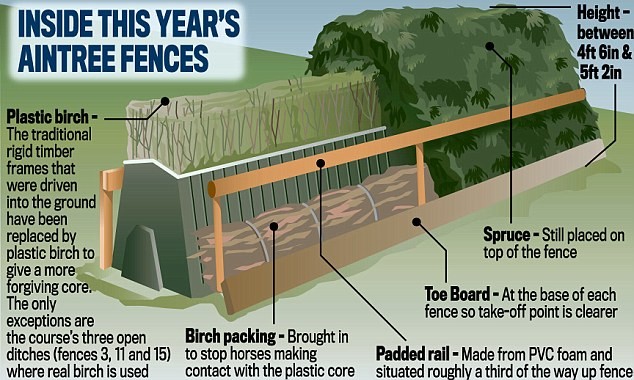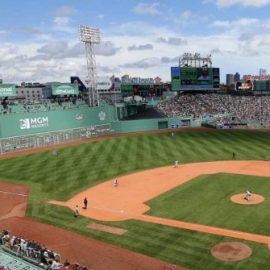The Grand National is the world’s greatest steeplechase and is a horse race that grabs the attention of racing fans from around the globe. It’s also an event that’s steeped in history, famous stories and Grand National tales, plus has some of the most famous fences to be jumped. So, if you don’t know the Becher’s Brook from The Chair, we are here to explain more about the Grand National fences.
Grand National Fences Guide
The Grand National fences are the most famous in the world and with the first running of the Grand National in 1839 then over the years the fences and obstacles for the horses to tackle have evolved. Let’s take a look in more detail at how high are the Grand National fences and how many Grand National fences are jumped.
How Many Fences Are In The Grand National?
Over the 4m 2 1/2 furlong distance of the Grand National there are a total of 16 fences on the course. 14 of the Grand National fences are jumped twice – meaning in total there are 30 fences to be jumped for the Grand National runners.

The Grand National Fences Explained
Fences 1 and 17 (4ft 6in high) – The first fence jumped in the Grand National eases the horses in gently as it’s one of the smallest on the course. That’s not to say it doesn’t catch some out – in 2021 Lake View Lad was a first fence faller. Jumped twice.
Fences 2 and 18 (4ft 7in high) – Just an inch higher than the opening fence, but is a fair bit wider at 3f 6in, so takes a bit more jumping. Jumped twice
Fences 3 and 19 (5ft high) – The first of three open ditches in the Grand National and at 5f high is taller than the opening two fences. Jumped twice.
Fences 4 and 20 (4ft 10in high) – Slighlty lower than the previous fence – jumped twice.
Fences 5 and 21 (5f high) – This fence was modified in 2013 with the landing side levelled out. Jumped twice.
Fences 6 and 22 BECHER’S BROOK (4th 10in high) – The Grand National fence that is talked about the most. Named after Capt Martin Becher, who landed in the ditch of this fence in the first Grand National in 1839. Jumped twice
Fences 7 and 23 FOINAVON (4ft 6in high) – A fence like most of the others in the Grand National but become more famous is 1967 after a pile-up at the fence saw the only horse to run it – Foinavon. Jumped twice
Fences 8 and 24 CANAL TURN (5ft high) – Another of the famous Grand National fences – named after the nearby Liverpool-Leeds canal and has a 90-degree left-handed turn straight after it’s jumped – meaning horses tend to try and jump this fence at an angle. Jumped twice.
Fences 9 and 25 VALENTINE’S BROOK (5f high) – Another big-name fence that has a 5ft 6in brook on the landing side. Named in 1840 after a horse called ‘Valentine’ was meant to have jumped the fence with it’s hind legs first. Jumped twice.
Fences 10 and 26 (5f high) – Jumped twice.
Fences 11 and 27 (5th high) – Back to another open ditch here – become famous in 1935 when the warm favourite – Golden Miller – fell after refusing to jump the fence. Jumped twice.
Fences 12 and 28 (5ft high) – Has a 5f 6in ditch on the landing side and is sometimes referred to as the ‘Booth’ – named after former Aintree head maintenance man in the 1970’s. Jumped twice.
Fences 13 and 29 (4ft 7in high) – Modified in 2013, with the landing side smoothed out. Jumped twice.
Fences 14 and 30 (4ft 6in high) – One of the smaller Grand National fences – meant to be an easier fence to jump before tackling the highest fence next – The Chair. Jumped twice.
Fence 15 THE CHAIR (5ft 2in high) – The highest fence in the Grand National and has a 5 foot ditch before the fence too. With a raised landing side it provides a different test for both horse and jockey. Is only jumped once on the first circuit.
Fence 16 WATER JUMP (2ft 6in high) – Is the final fence on the first circuit and also the lowest of all the fences jumped in the Grand National. The water was introduced in 1841 – replacing a stone wall. Jumped only one on the first circuit.
How Tall Are The Grand National Fences
You can see above each height of the Grand National fences – but they range from the smallest (Water Jump), which is 2ft 6in high, to the tallest Grand National fence – The Chair – which stands at 5f 2in.
The Famous Grand National Fences
The Chair
Is the second last fence jumped on the first circuit and is only jumped once in the race. At 5 foot 2 inches, The Chair is the highest fence jumped in the Grand National. It also has a ditch before the fence – meaning horses have to take off well before jumping it. Then with a slightly raised landing side (6 inches) this provides a further test of both jockey and horse.
The Chair got it’s name as during the early Grand National days a judge would sit near the fence (on a chair) to record the finishing position of the horses. This process ended in 1850, but the area still has a monument where the judges chair once stood. Hence why the fence was originally called the Monument Jump, but became better known as ‘The Chair’ in the 1930’s.
Becher’s Brook
Probably the most famous Grand National fence. At 4f 10 inches it’s one of the higher fences, but with a lower landing side to take off, then it can often catch horses out. The fence also have a left-handed turn on landing, so that combined with the jumping test it provides makes it one of the most thrilling fences to be jumped in the Grand National.
Valentine’s Brook
Is the third of four of the better-known Grand National fences to be jumped in a row. Gained it’s name in 1840 after a horse called ‘Valentine’ was reported to have somehow jumped the fences with it’s hind legs first!
Canal Turn
Named after the Leeds/Liverpool canal that runs in front of the horses after they jump the fence. The Canal Turn also has a 90 degree turn after it’s jumped (left-handed), meaning horses often jump the fence at an angle to try and cut the corner and save ground. The Canal Turn fence is jumped twice during the race.
Foinavon
Was a normal fence during the early Grand National years, but become famous overnight in 1967 when 100/1 shot – Foinavon – managed to avoid a mass pile-up at the fence and was the only horse to jump it. The 9 year-old went from last to first after swerving the other horses that failed to jump the fence and went into win the 1967 Grand National at monster odds.
Water Jump
The smallest Grand National fence to be jumped at just 2ft 9in. Is only jumped once (last fence on the first circuit) in the race on the first circuit and being it’s situated in front of the stands, gives the crowd plenty to cheer.
On the final circuit – the Grand National runners bear right (the elbow) to avoid the Chair and Water Jump – to storm up the run in towards the finishing post.
Grand National Facts and Figures
With over 180 years of Grand National history there are plenty of interesting facts and figures that have built-up over the years. We take a look at the key trends and stats that can help you find the best profile of past Grand National winners.
Who Is The Current Grand National Favourite?
One of the big questions horse racing fans ask in early April is – which horse is going to be the Grand National favourite? With a maximum of 40 Grand National runners it’s always competitive in the betting to see which horse will be carrying the bulk of punter’s money – so let’s take a look at some of the contenders to be the 2022 Grand National favourite.
Grand National Trends
With 40 Grand National runners to wade through, then trying to find the winner of the Aintree Grand National is not an easy task. However, with over 180 years of history, the ‘good news’ is there’s loads of past Grand National trends and stats to help find the best profiles of past winners of the world’s greatest steeplechase.
Grand National Runners
Knowing who the Grand National runners are is important if you’re betting on the main at Aintree Racecourse. This is all about the horses hoping to run in the world’s most famous steeplechase. We have all the Grand National runners and riders this year, plus plenty more besides.
How To Watch The 2022 Grand National
The excitement is building by the day ahead of the 2022 Grand National, which will be run on Saturday 9th April. It’s a horse race that’s littered with history and also an event racing fans from around the world love to see – but what are the easiest ways to watch the Grand National this year?
Grand National Best Betting Offers
The build up towards the 2022 Grand National, which will be run on Saturday 9th April, is hotting up by the day. So, to help you enjoy the ‘world’s greatest steeplechase’ here at SportLens we’ve put together a comprehensive Grand National free bets and offers guide for you.
Our bookmakers will offer new and registered Grand National customers some exciting free bets, so you can even have a wager on the Grand National and it won’t cost you a penny – while there are also many Grand National offers for existing customers to take full advantage of.
Grand National Free Bets
Add Sportslens to your Google News Feed!








